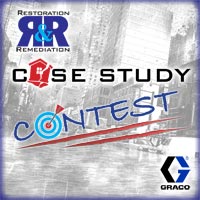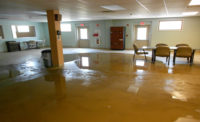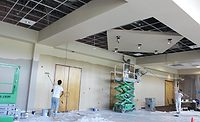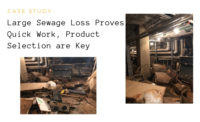CASE STUDY CONTEST 2017
Large Loss Monsoon Damage – Kowalski Construction

Inventory Relocation: More than 2,500 pallets of carefully stored inventory had to be relocated before restoration could begin.

Before the inventory was relocated, these scissor lifts couldn’t fit between the shelves.

A 40’x65’ wooden platform was built on top of the existing racks in order to provide a base from which workers could access the ceiling.

Another view of the wooden platform.

To maximize safety, a railing was also built around the platform.






Describe this restoration project.
A warehouse space of 111,159 square-feet sustained water damage due to a monsoon storm that blew off 3,900 square feet of roofing. In addition, the damage caused a microbial infestation which required remediation. A roof truss was broken in the process as well, and needed repair. The total cost of the temporary emergency service and repairs was $203, 577.38.
Tensions were high on both the insurance company and ownership sides, as everyone was aware of the ongoing litigation for the nearly identical previous claim. Managing everyone’s expectations and preventing this claim from also becoming a legal nightmare turned out to be the biggest challenge of all. Though understandable, it would be an understatement to say that there were trust issues on both sides of this project. In the end, we were successful in building that trust and confidence, which allowed us the autonomy to move quickly and respond appropriately to the changing conditions. The owner thanked us profusely, expressing his gratitude for the outcome of this claim, which was such a stark contrast to his previous experience. The insurance company was both relieved and thankful that under these trying conditions, we were able to prevent this claim from following in the footsteps of the previous one. The mold was remediated, repairs completed and the warehouse was returned to full operation within two months’ time.
Click here to vote!
What challenges did you face and how did you overcome them?
This warehouse was four stories tall and was stocked full of merchandise. Storage capacity was maximized by using racking systems. However, these racks did not allow enough space for the 40’ scissor lifts required for our demolition and repair work. It was therefore necessary to remove four sections of racking to create the necessary aisle space. We had to coordinate access to the premises and organize over 2,500 pallets to remove the racks and stored merchandise. This required the use of three semi-trucks running around the clock for two days. With the merchandise and racking out of the way, we built a 40’x65’ wooden platform on top of the existing racks in order to provide a base from which we could access the ceiling. Working from the existing racking to construct the platform and catwalk over 30’ off the ground posed several challenges and safety concerns. We built railing and outriggers around the perimeter to better secure the area. A huge containment was also erected in order to protect the unaffected areas of the warehouse. Eleven negative-air scrubbers were utilized during the microbial remediation process. While working on the platform during the remediation process, closer inspection revealed that the infestation covered a larger area than previously known. The platform then had to be expanded to 65’x60’ and the containment was extended to 105 feet long, x 60 feet wide x 40 feet tall in order to accommodate the larger remediation workplace. Overhead lights were deemed unsafe to operate until replaced so we established a battery-powered temporary lighting system. We also installed an additional power panel as there were not a sufficient number of existing outlets in the area to operate our tools and equipment. If all of this didn’t present enough of a challenge, the owner and insurance company were still dealing with a $3 million claim and lawsuit from a very similar type of loss that had occurred 24-months ago. That work was not performed by Kowalski Construction, and litigation was ongoing as we worked on the second claim. Confirmation that the Insurance Company was concerned about the second claim escalating was evident in the fact that they assigned an International Adjuster to handle the loss. This adjuster told us that he only handled claims over $100-million and was one of only a handful of such adjusters in the world.
Click here to vote!
Looking for a reprint of this article?
From high-res PDFs to custom plaques, order your copy today!










